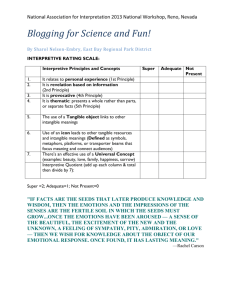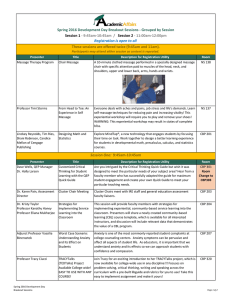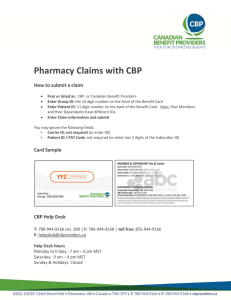Customer Benefits Package: Definition & Application
advertisement
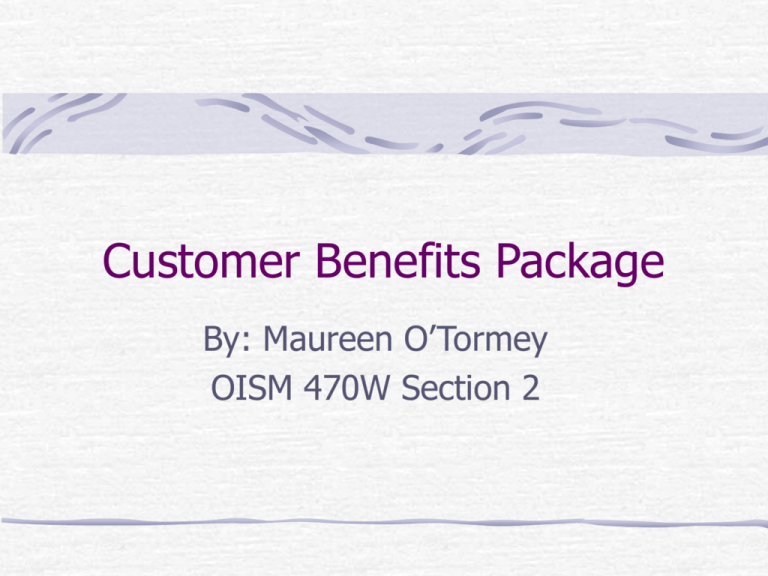
Customer Benefits Package By: Maureen O’Tormey OISM 470W Section 2 Objectives Tool definition Application Examples Exercises Objectives What is a Customer Benefits Package (CBP)? Ways to use this tool Why should your company use this tool? What is a Customer Benefits Package? Definition A tool that defines the physical goods as well as the non-physical goods of a service. This package is for the customer. Both types of goods form the total product or the complete service. Benefits Establishes the key aspects of the service Provides employees with guidelines for the service Gives the customer knowledge about the service What’s provided within the service What’s not provided within the service Brainstorming Exercise Do your customers know what they are getting from your product/service? In what ways could this tool help your company perform better? What would your company’s Customer Benefits Package look like? Know Your Customer Target markets Specifications and expectations of your customer Benefits that are important to them Ways to search for this information Tangible vs. Intangible Goods Tangible Associated with the physical aspects of a service The things that you can touch and see Examples: Food at a restaurant Car parts at an auto repair shop Contents of a room at a hotel, etc. Tangible vs. Intangible Goods Intangible Associated with the actual service Not something you can touch or see Examples: Convenience Reliability Reputation Three Elements of a CBP Primary Circumstance Peripheral Variant Primary Circumstance Things recognizable physically by the customer Similar to tangibles discussed in the previous slides The good that the customer uses or pays for Peripheral Along the lines of the service itself Similar to the intangible contents of the benefits package Satisfy great wants by the customer such as a good reputation Variant An attribute that is different from the ordinary How the customer benefits package is produced Customization Different design aspects Four Different Service Packages Unique Selective Restricted Generic Unique Service Packages Very specific and original Flexible Change with every different customer Examples of industries that would typically use this type of package: Law firm Accounting firm Selective and Restricted These two are very similar in nature Some specifics, but not many Some flexibility CBP can apply to several different customers Example of an industry: Auto repair shop Generic The title gives away the definition A CBP that can apply to all customers Very broad and general Example of industries: How To Use This Tool A way to inform your customers what your company will and will not be providing with the service A way to safeguard your company against any discretions that might occur with an unsatisfied customer Other Ways to Use This Tool Companies use it as a way to help in advertising for their service Use the benefits listed in the package as a focal point for ads Real World Example An example of a customer benefits package is from a company called Network What they do is network companies They do marketing research for them They collect data and provide many other services for companies Network’s CBP Network’s CBP informs their current and potential clients on becoming a member They have a list of 12 attributes that tell specifically what Network does and how it helps their members Under each attribute, there is a statement saying exactly what Network does A CBP Exercise List both the tangible and intangible goods that would be found in a Customer Benefits Package for the following company: A drive through car wash chain What Did You Learn? What a customer benefits package is What the essential parts that make up the service package are The different kinds of service packages according to the type of industry your company is in What Did You Learn? Different ways to use a customer benefits package How real companies use them How to come up with the tangible and intangible goods that should be in the CBP Bibliography “Customer Benefit Package.” Internet. Http://www.fundacion.telefonica.com/ul timo/aesopian /advanced/01010200.htm. 13 February 2001. Foster, S. Thomas, “Managing Quality: An Integrative Approach.” 2001, 240242. Bibliography “Marketing Research.” Internet. Http://www.callnetwork.com/becoming_a_net work_member.html. 13 February 2001. Passewitz, Gregory R. and Nancy H. Bull. “Advertising: An Investment In Your Business’s Future.” Internet. Http://www.ag.ohio-state.edu/~ohioline/cdfact/1276.html. 13 February 2001.





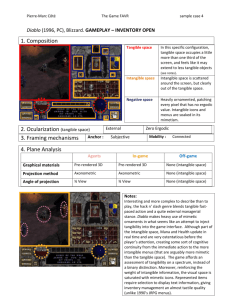

![CustomerBenefitPackages[1]](http://s2.studylib.net/store/data/015258258_1-5090c38a493581c756854f35540077c5-300x300.png)
